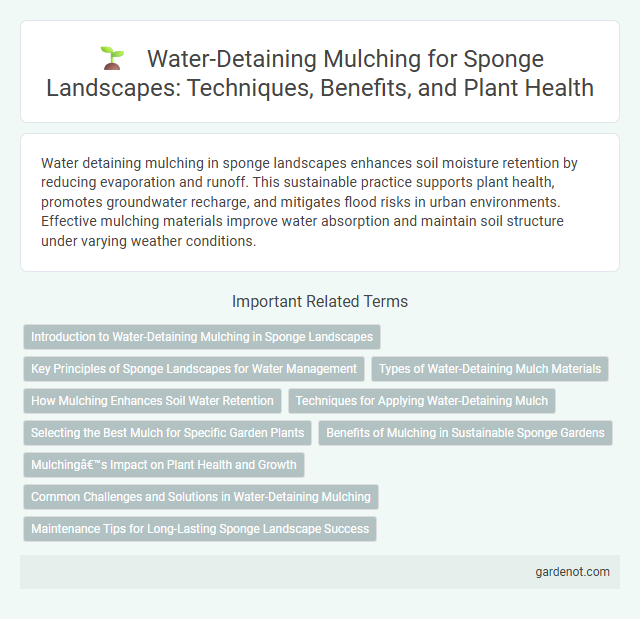Water detaining mulching in sponge landscapes enhances soil moisture retention by reducing evaporation and runoff. This sustainable practice supports plant health, promotes groundwater recharge, and mitigates flood risks in urban environments. Effective mulching materials improve water absorption and maintain soil structure under varying weather conditions.
Introduction to Water-Detaining Mulching in Sponge Landscapes
Water-detaining mulching in sponge landscapes enhances soil moisture retention by reducing evaporation and promoting infiltration, creating optimal conditions for plant growth and groundwater recharge. Materials such as organic compost, straw, and biochar serve as effective mulches that increase water-holding capacity and support microbial activity. This practice is vital for mitigating urban runoff, reducing flood risks, and sustaining ecosystem resilience in sponge city designs.
Key Principles of Sponge Landscapes for Water Management
Water detaining mulching in sponge landscapes enhances infiltration by creating a permeable layer that reduces runoff and promotes soil moisture retention. Key principles include using organic or permeable mulch materials that support soil structure while enabling gradual water absorption and release. This practice optimizes urban water management by mitigating flood risks and improving groundwater recharge.
Types of Water-Detaining Mulch Materials
Water-detaining mulching materials play a critical role in sponge landscape design by enhancing soil moisture retention and reducing runoff. Common types include organic mulches like straw, wood chips, and compost, which improve soil structure and nutrient content while retaining water. Inorganic options such as gravel and geotextiles provide durable moisture barriers that facilitate controlled water infiltration and reduce evaporation.
How Mulching Enhances Soil Water Retention
Mulching significantly improves soil water retention by reducing evaporation and maintaining consistent moisture levels within the soil profile. Organic mulch materials increase water infiltration rates and promote microbial activity, enhancing soil structure and porosity. These effects collectively support sustainable water management in sponge landscape designs by optimizing water availability for plants.
Techniques for Applying Water-Detaining Mulch
Water-detaining mulch enhances soil moisture retention by creating a protective layer that reduces evaporation and promotes infiltration. Techniques for applying water-retaining mulch include spreading a uniform 2-4 inch layer of organic materials such as straw, wood chips, or coconut coir directly onto the soil surface, ensuring full coverage around plant roots. Incorporating hydrogels or superabsorbent polymers within mulch can further increase water retention capacity, especially in sponge landscape environments aiming to optimize water conservation.
Selecting the Best Mulch for Specific Garden Plants
Selecting the best mulch for specific garden plants in a sponge landscape involves prioritizing water-retention capacity and soil moisture regulation. Organic mulches such as shredded bark, straw, and composted leaves effectively detain water, reduce evaporation, and improve soil health. Choosing a mulch tailored to plant species' water needs enhances efficient water use and supports sustainable garden growth.
Benefits of Mulching in Sustainable Sponge Gardens
Mulching in sponge landscapes enhances water retention by reducing soil evaporation and improving moisture infiltration, fostering healthier plant growth. This technique minimizes surface runoff and erosion, contributing to groundwater recharge and urban flood resilience. Organic mulches also enrich soil quality by adding nutrients and supporting microbial activity, promoting sustainable, low-maintenance gardens.
Mulching’s Impact on Plant Health and Growth
Mulching in sponge landscapes significantly enhances water retention by reducing surface evaporation and improving soil moisture levels, which directly supports plant health and growth. Organic mulches contribute nutrients as they decompose, fostering robust root development and increasing plant resilience against drought stress. Consistent moisture availability and nutrient supply from mulching result in increased photosynthesis efficiency and higher overall biomass production in vegetation.
Common Challenges and Solutions in Water-Detaining Mulching
Water-detaining mulching faces common challenges such as uneven moisture retention, mulch displacement due to wind, and potential fungal growth from excessive moisture. Solutions include using textured or layered mulch materials to enhance absorption and stability, applying biodegradable binders to secure mulch in place, and selecting mulch types with antifungal properties to prevent pathogen development. Effective water detaining in sponge landscapes relies on optimizing mulch composition and installation techniques to balance moisture conservation with soil aeration.
Maintenance Tips for Long-Lasting Sponge Landscape Success
Water detaining mulching in sponge landscapes requires regular inspection to ensure mulch layers remain evenly distributed and adequately thick, typically maintaining a 3 to 5 cm depth to optimize water retention and soil moisture. Replenish organic mulch materials such as wood chips or straw annually to prevent decomposition-related gaps that reduce effectiveness in water detention. Avoid compacting mulch layers during routine maintenance to maintain porosity and promote infiltration, thereby sustaining the performance of sponge landscape systems.
Water detaining mulching Infographic

 gardenot.com
gardenot.com